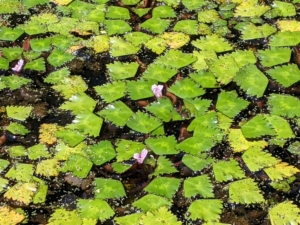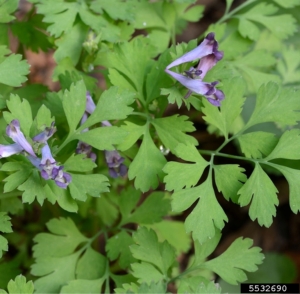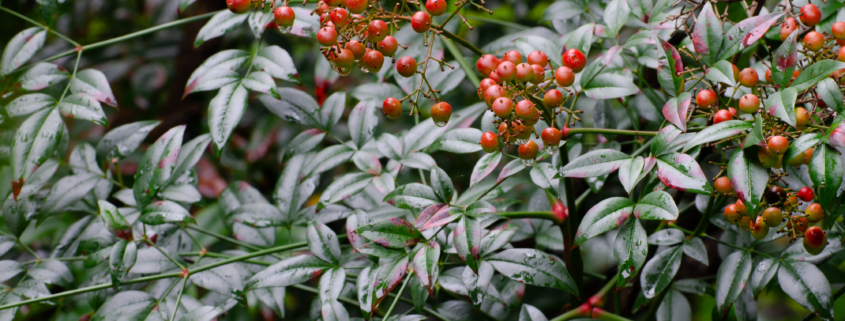13 Species Added to Virginia Invasive Plant Species List
Photo: Nandina (Nandina domestica)
Press release and photos provided by Virginia Department of Conservation and Recreation
Gardeners encouraged to plant alternatives to Italian arum, nandina and others
RICHMOND, VA, October 8, 2024 — Thirteen more species that pose a threat to the state’s ecosystems have been added to the Virginia Invasive Plant Species List.
The additions include Italian arum (Arum italicum), nandina (Nandina domesticum) and orange-eye butterfly-bush (Buddleja davidii).
Invasive plants are non-native species that cause harm or have the potential to cause harm to natural resources, economic activity or humans. Some have been introduced intentionally into a region where they did not evolve; others, accidentally.
The Virginia Department of Conservation and Recreation (DCR) has determined that the plants on the list, which now includes 103 species, threaten Virginia’s forests, marshes, wetlands and waterways. The list, which has no regulatory authority, is for educational purposes and is updated regularly. For the full list, go to: https://www.dcr.virginia.gov/natural-heritage/invsppdflist.
“DCR’s Natural Heritage Program has updated and provided this list for more than a decade, as a ‘know before you grow’ tool for citizens,” said Virginia Natural Heritage Program Director Jason Bulluck. “New invasive plant species are continuously arriving in Virginia, so it is important for landowners and land managers to stay aware of the threats, to prevent invasive species establishment and to be swift in recognizing and managing their spread. Anyone who has ever found themselves battling an invasive species infestation knows ‘an ounce of prevention is worth a pound of cure.’”
Factors considered during assessment of potential additions to the list include the invasive characteristics of the species such as how readily seeds are dispersed through the landscape, whether Virginia has suitable habitat and if the species threatens natural resources. There are three ranks of invasiveness: high, medium or low.
Invasive plants cause problems because they proliferate and displace native plant species, reduce wildlife habitat and alter natural processes.

Two-horned trapa (Trapa bispinosa).
For instance, a new aquatic invasive plant with sharp, spiky fruit known as two-horned trapa (Trapa bispinosa) has been rapidly proliferating in freshwater ponds, lakes and slow-moving waterways in northern Virginia and elsewhere. It harms the ecosystem by forming mats that choke and cover waterbodies, shading out and competing with native submerged aquatic vegetation and reducing dissolved oxygen with its decayed roots and leaves. Infested waters lose boating, fishing, recreational and aesthetic value. Management is costly.
The state’s Invasive Species Working Group, created by the Virginia General Assembly in 2009, is coordinating efforts to address invasive species and is updating its management plan.
DCR Stewardship Biologist Kevin Heffernan said that a cultivar (“cultivated variety”) is sometimes propagated to be sterile so that it won’t spread. However, in some cases like the Bradford pear (Pyrus calleryana), the cultivar can cross with other cultivars or the original species, thereby reproducing and spreading to extents that are very difficult, expensive or even impossible to ever manage.
“We think of plants as being rooted where you plant them. But many species have reproductive means by which to travel far from the parent plants: seeds “hitchhiking” on people and animals, seeds catching a ride on the wind, or plant parts floating on water to a new habitat. Thus, species like tree-of-heaven, wavyleaf grass, two-horned trapa, and even butterfly-bush, can show up where you least expect to find them, places like local forest parks or natural area preserves,” he said.
“If you learn you have an invasive species in your yard or garden, whether or not you planted it there, we strongly encourage removal. There are many horticultural species that are not invasive. And, more and more, native plant species are available for a variety of settings. Often, the native species we plant in our yards benefit birds, butterflies and other pollinators, whose presence enriches our garden experience and increases ecological value.”
DCR provides a free, online Virginia Native Plant Finder tool to search for native species to plant instead of invasives. Go to https://www.dcr.virginia.gov/natural-heritage/native-plants-finder.
To report a sighting of an invasive plant in Virginia, use the EDDMapS website or app, iNaturalist or visit: https://www.invasivespeciesva.org/report-sightings.
Added to Virginia Invasive Plant Species List
Virginia Invasiveness Rank: High
- Chinese tallow-tree (Triadica sebifera)
- floating primrose-willow (Ludwigia peploides var. glabrescens)
- Italian arum (Arum italicum)
- ravenna-grass (Tripidium ravennae)
- trifoliate orange (Citrus trifoliata)
- two-horned trapa (Trapa bispinosa var. iinumai)
Virginia Invasiveness Rank: Medium

Incised fumewort (Corydalis incisa)
- curled pondweed (Potamogeton crispus)
- fountain grass (Cenchrus purpurascens)
- incised fumewort (Corydalis incisa)
- leatherleaf mahonia (Mahonia bealei)
- sweet autumn clematis (Clematis terniflora)
Virginia Invasiveness Rank: Low
- nandina (Nandina domestica)
- orange-eye butterfly-bush (Buddleja davidii)




